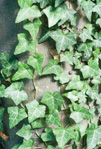

Ivy, Hedera helix, is mentioned only in the Apocrypha, though it played a major role in several civilizations in the Mediterranean. Here ivy is climbing a tree, attaching with the specialized roots that arise from the stem, in Norfolk, Virginia.
HOLLY AND IVY ARE WELL-KNOWN holiday symbols. It is surprising to learn, therefore, that in ancient times their use was proscribed by Jews and early Christians. This restriction was probably because of the association of holly and especially ivy with Greek gods (Baumann 1993) and with garlands for wreaths and crowns of Apollo, which was idolatry (Forster 1952).
“People [Jews] were driven by hard compulsion to take part in the monthly ritual meal commemorating the king’s birthday; and when a feast of Dionysius occurred, they were forced to wear ivy wreaths and walk in the Dionysiac procession. A decree was issued at the instance of the people of Ptolemais for the neighbouring Greek cities, enforcing the same conduct on the Jews there, obliging them to share in the sacrificial meals, and ordering the execution of those who would not voluntarily conform to Greek customs. So it became clear that disaster was imminent” (II Maccabees 6:7–9, NJB). The mandatory wearing of ivy and the atrocities inflicted on the Jews compelled to participate in these events would be enough to render ivy an anathema.
Dislike of these plants was mitigated in the Middle Ages (Trapp 1958), so that today, ivy, and to a greater extent holly, are associated with Christmas and New Year celebrations.
Ivy on rock face on Mount Lebanon. Courtesy Houssam Shaiban.
The plant of the dictum against garlanding is the common English ivy, Hedera helix, widely distributed throughout the Mediterranean region and much of Europe (Metcalfe 2005). It is a woody vine with evergreen leaves and can often climb very high. I have seen it in mature mixed-hardwood forests in Lebanon and Syria, but it is not as common there as in Anatolia and on the Greek peninsula. In nature, ivy climbs up forest trees, firmly attaching itself to the supporting surface with specialized roots. The clasping nature of the vine has been used in literature as a symbol of cleaving to a person in affection. Ivy flowers appear late in the year, followed by a purple-black berry. English ivy is widely planted for its attractive evergreen leaves and for the fruits, which are nutritious food for birds.